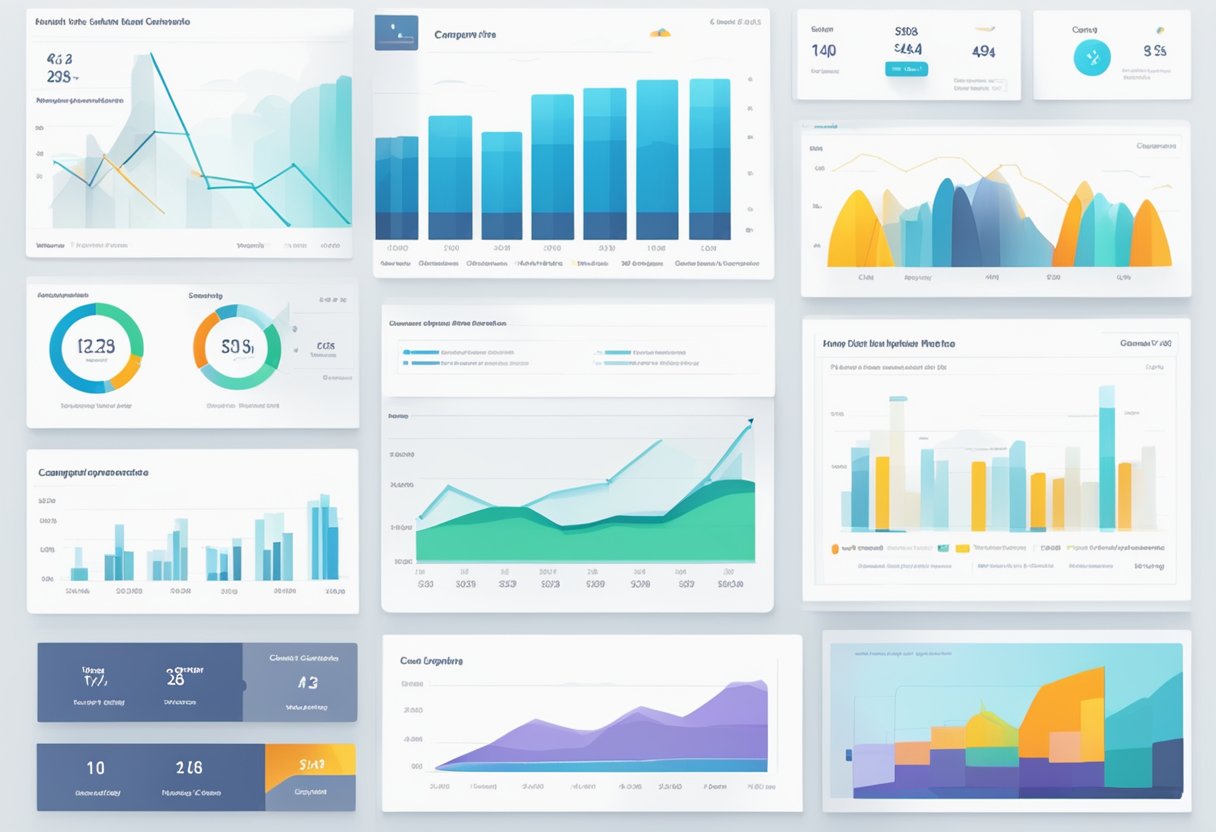LinkedIn has become a cornerstone platform for B2B marketing, allowing businesses to tap efficiently into a professional audience. Grasping the basics of LinkedIn advertising is essential, with a focus on establishing a robust bidding and budgeting strategy that underpins successful campaign outcomes. Balancing cost with campaign effectiveness requires insight into the platform’s ad bidding mechanisms and thoughtful budget allocation aligned with clear campaign objectives.

Understanding the nuances of LinkedIn’s advertising platform is critical, with options such as Maximum Delivery and automated bidding that leverage historical data and member behaviour to optimise bids. However, a tailored approach that considers target audience characteristics and measures the efficacy of ad content can significantly impact overall campaign performance. Continuously tracking and analysing performance data ensures that advertisers can refine their strategies, ensuring they are always working towards maximum return on investment.
Key Takeaways
- Effective LinkedIn advertising combines strategic bidding with clear budgeting.
- Tailored ads targeting the right audience enhance campaign success.
- Continuous optimisation is key to achieving a higher ROI.
Understanding LinkedIn’s Advertising Platform
LinkedIn’s advertising platform operates on an auction-based system, where advertisers can bid for ad placements. Each campaign an advertiser runs enters into a real-time bidding process that determines the visibility of the ads. This system is key to understanding how to effectively reach a target audience.
The platform offers several ad formats, including Sponsored Content, Message Ads, and Text Ads. These formats cater to various objectives, such as brand awareness, lead generation, and website visits.
Bidding Strategies are crucial in managing ad campaigns. LinkedIn suggests focusing on bid types that align with marketing goals. Advertisers set a maximum bid – the highest amount they’re willing to pay for an ad action, like a click or impression.
Budgeting on LinkedIn involves setting a daily budget or a total budget for campaigns. A daily budget is the amount one is willing to spend each day, while the total budget sets a cap for the entire campaign duration.
- Auction Type: LinkedIn uses a second-price auction, where the advertiser pays just above the second-highest bid, not their maximum bid.
- Bid Types: Cost per Click (CPC), Cost per Impression (CPM), and Cost per Send (CPS) are available bid options.
Advertisers must balance budget constraints with the need to make competitive bids. Effective targeting greatly influences budget efficiency. It is advised to limit targeting to essential features, especially when dealing with a smaller budget, to reach a more relevant audience.
For insights on crafting an effective strategy, one can refer to practical advice on creating a bidding and budgeting strategy, which can help achieve the desired campaign results on LinkedIn.
Setting Clear Campaign Objectives

When embarking on a LinkedIn advertising campaign, establishing clear objectives is tantamount to directing your efforts efficiently. Advertisers need to pinpoint what they want to achieve with their campaign, as this decision steers subsequent choices in the ad creation process.
Identify Your Goals: Is the aim to generate leads, increase brand awareness, or drive event registrations? Each goal corresponds to specific LinkedIn campaign objectives that you can select within the Campaign Manager. By defining a goal, the platform can tailor the campaign to achieve better results.
Select the Right Objective: LinkedIn offers a variety of campaign objectives such as ‘Website Visits’, ‘Engagement’, and ‘Video Views’. Choosing the objective that aligns with the campaign’s goals is crucial for its success. The chosen objective determines available ad formats and influences bidding strategies.
- Lead Generation: Focuses efforts on collecting lead data.
- Website Conversions: Oriented towards driving specific actions on a website.
- Job Applicants: Aimed at recruiters seeking quality candidates.
Measure Success: A clearly defined objective allows for the measurement of a campaign’s success against its initial goals. LinkedIn’s Campaign Manager provides a range of metrics suited to the chosen objective, enabling advertisers to track and optimise their campaigns effectively.
Budget Alignment: The campaign objective impacts how budget is utilised. With a precise objective in mind, allocating funds becomes more strategic and deliberate, maximising the chance of a favourable return on investment.
For those seeking guidance on setting campaign objectives, LinkedIn offers resources, such as a detailed exploration of setting objectives for ad campaigns that provide best practices and insights.
Determining Your Target Audience
The success of LinkedIn advertising campaigns hinges on accurately identifying the group of LinkedIn users most likely to engage with the ads. This precision ensures optimal use of resources and maximised impact.
Defining Buyer Personas
A buyer persona is a semi-fictional representation of the ideal customer based on market research and real data about existing customers. Companies must articulate these personas with specific attributes such as job title, industry, company size, and professional interests. For example, for Text Ads, LinkedIn Marketing Solutions recommends keeping the target audience between 60,000 and 600,000 members, aligning closely with the defined buyer personas.
Leveraging LinkedIn’s Audience Targeting Features
LinkedIn’s advertising platform offers a rich set of targeting features that can pinpoint users by job experience, education, skills, and even group memberships. Advertisers should utilise these options to match their buyer personas closely and limit targeting to the most relevant features. A precise audience allows advertisers to direct their budget where it is most effective, ensuring that campaigns reach individuals most likely to convert. For more actionable insights, advertisers can refer to the best practices on audience targeting provided by LinkedIn.
Establishing a Budget Strategy
When approaching LinkedIn advertising, it’s essential to define a well-structured budget strategy. This involves understanding the principles for allocating funds and mastering techniques to keep costs under control.
Budget Allocation Principles
A marketer must pinpoint the specific objectives of their LinkedIn campaign to ensure funds are allocated effectively. It’s usually advised to begin with a clear understanding of the target audience and desired outcomes. For instance, a principle of focused targeting could be to prioritise key demographics or job functions, ultimately making budget spend more efficient and impactful.
The practice of dynamic reallocation is crucial; companies often adjust campaign funds based on performance metrics. This might entail shifting budget towards high-performing ads or demographics that demonstrate better engagement and conversion rates.
Cost Control Techniques
To control costs, advertisers should set maximum bids for cost-per-click (CPC) that align with their company’s customer acquisition cost. For instance, if the value of a lead is estimated at £50, the CPC bid should be set at a figure that ensures profitability, such as £5 per click to safeguard against diminishing returns.
Employing daily budget caps can prevent overspending and encourage the LinkedIn algorithm to optimise ad delivery throughout the day. This technique aligns spending with peak audience activity periods. Additionally, monitoring and tweaking budgets weekly can ensure resources are not wasted on underperforming ads.
Bidding Fundamentals
In LinkedIn Advertising, understanding the bidding process is critical for the efficient use of budget and achieving advertising objectives. Properly structured bids can significantly enhance ad performance and return on investment.
Bid Types Explained
LinkedIn bids are primarily auction-based, meaning advertisers compete to have their ads shown to the platform’s users. They offer several bidding options tailored to different campaign goals and levels of control required:
- Second-Price Auction: The advertiser only pays one penny more than the second-highest bidder.
- Manual Bidding: It gives advertisers full control over bid amounts, although it requires close monitoring.
- Automated Bidding: LinkedIn’s system sets the bid based on historical data, aiming to optimise for the best results.
The bidding overview on LinkedIn elucidates how each bid works in detail.
Optimising Bids for Campaign Goals
Different campaigns have varying objectives, from maximising impressions to generating leads.
- For brand awareness, automated bidding might be suggested due to its ability to maximise the ad’s reach.
- For lead generation or other conversion-based goals, manual bidding might provide better cost control whilst targeting specific prospects.
Effective bid optimisation strategies are aligned with the campaign’s ultimate goals, whether that’s driving website traffic or boosting content engagement. A guide to creating effective bidding strategies on LinkedIn suggests starting with the recommended bid and adjusting according to performance data.
Crafting Effective Ad Content
The success of LinkedIn Advertising relies heavily on the dual keystones of engaging ad copy and captivating visuals. Both elements must work in harmony to grab attention and persuade LinkedIn users to take action.
Creating Compelling Ad Copy
The ad copy is the brand’s voice on LinkedIn, and it must resonate clearly with its intended audience. To achieve this, advertisers should focus on brevity and relevance, ensuring the message is succinct and displays a strong value proposition. It is vital to use clear, action-oriented language that encourages the user to interact with the ad. Moreover, incorporating customised copy for different LinkedIn segments enhances the ad’s ability to engage diverse professionals.
Designing Eye-catching Ad Visuals
Visuals can often speak louder than words, and in LinkedIn ads, this is no exception. Advertisers should employ high-quality images or graphics that align with the brand identity and complement the ad copy. The use of colours and composition should direct the viewer’s eye to the most important part of the message. Incorporating branded elements subtly can also increase ad recall. It’s essential for visuals to be optimised for different device screens, ensuring clarity and impact are consistent across all user experiences.
Leveraging LinkedIn’s Ad Formats
To maximise LinkedIn Advertising campaigns, it’s essential to understand and effectively utilise the platform’s diverse ad formats. Each format caters to different objectives and audiences, necessitating a strategic approach to selection and content customisation.
Choosing the Right Ad Format
LinkedIn offers several ad formats, each with unique features and advantages. Text Ads are simple yet powerful; these are ideal for driving traffic to a website or landing page with short, compelling copy. Sponsored Content appears directly in the LinkedIn feed, blending in with organic posts, thus fostering higher engagement rates. When deciding on the format, advertisers should consider their campaign goals, target audience, and budget to determine which format aligns best with their strategy.
Best Practices for Sponsored Content
For Sponsored Content, visuals are key. High-quality images or videos can significantly increase the click-through rate. Here are some tips to ensure effectiveness:
- Visuals: Use eye-catching imagery or video content to stand out in busy LinkedIn feeds.
- Conciseness: Keep messages to the point; clarity and brevity often lead to better engagement.
- CTA: Include a clear call-to-action (CTA), guiding users to the next step.
- A/B Testing: Regularly test different creative elements to determine what resonates best with the audience and refine accordingly.
By adhering to these guidelines, marketers can leverage LinkedIn’s ad formats to create impactful campaigns that engage and convert.
Performance Tracking and Analytics

To effectively manage LinkedIn advertising campaigns, advertisers must have a precise understanding of their performance metrics. This grasp is pivotal to optimise expenditure and achieve the best return on investment.
Key Performance Indicators
Key Performance Indicators (KPIs) are essential for advertisers to determine their campaign’s effectiveness. The most significant KPIs include conversion rate, click-through rate (CTR), and cost per acquisition (CPA). By monitoring these indicators, advertisers can gain insights into what adjustments may be necessary to improve performance. One should also consider:
- Lead Generation: The number of leads generated compared to the total spend.
- Engagement Rates: The level of interaction users have with the ads.
- Brand Awareness Metrics: Impressions and reach to measure visibility.
Utilising LinkedIn’s Analytics Tools
LinkedIn provides an array of analytics tools to help track campaign performance. By utilising LinkedIn’s analytics, one can delve into detailed campaign data and adjust strategies in real-time. Key tools include:
- Campaign Manager: This is LinkedIn’s central hub for advertising analytics. Here, users can see granular performance data.
- Conversion Tracking: Helps to pinpoint the actions taken on advertisers’ websites as a result of LinkedIn ads.
- Website Demographics: An incredible tool for understanding the professional traits of website visitors.
Through these tools, advertisers can refine targeting, manage bids more effectively, and ensure budgets are allocated to the most successful campaigns.
Optimising Campaigns for Maximum ROI
Effective LinkedIn advertising hinges on continuous campaign optimisation to ensure a maximum return on investment (ROI). This involves leveraging A/B testing strategies and iterative optimisation techniques to fine-tune bidding and budgeting approaches.
A/B Testing Strategies
A/B testing, or split testing, is paramount when refining ad performance on LinkedIn. Advertisers should run two variations of their campaign simultaneously to determine which yields better results. By comparing metrics such as click-through rates and conversion rates, marketers can identify and apply the most effective bidding strategies from their LinkedIn campaigns. It is essential to test one variable at a time — such as bids, ad copy, or target audiences — to accurately measure impact.
Iterative Optimisation Techniques
Iterative optimisation involves making continuous, data-driven adjustments to LinkedIn ad campaigns. This procedure demands regular analysis of campaign data and the flexibility to adjust bids and budgets in response to the insights gathered. To maximise PPC ROI, one must regularly review performance metrics and make small, incremental changes rather than significant overhauls, allowing for steady improvement without disrupting campaign momentum.
Compliance and Best Practices
In the realm of LinkedIn advertising, adherence to platform-specific ad policies and rigorous data privacy standards are paramount for success.
Understanding LinkedIn’s Ad Policies
When engaging in LinkedIn advertising, one must closely adhere to the LinkedIn Ad Policies. These rules govern the content and nature of advertisements, ensuring they are professional, honest, and free from offensive material. For instance, all advertisers are required to guarantee the accuracy of their information and avoid the use of misleading claims. It’s essential to consult the Best Practices for Bidding on LinkedIn for detailed guidance on bid strategies that align with these policies.
Maintaining Data Privacy and Security
Data privacy and security are of utmost concern in LinkedIn advertising. Advertisers have the responsibility to protect user data, align with General Data Protection Regulation (GDPR) standards, and ensure secure handling of all information. Strategies to achieve this include employing robust encryption for user data and transparently communicating how data is used. For comprehensive tips on establishing bidding and budgeting within these privacy frameworks, resources such as Establishing a Bidding and Budgeting Strategy for Your LinkedIn should be reviewed.
Scaling Your LinkedIn Advertising Efforts
When an advertiser decides to scale their LinkedIn advertising, careful consideration of bidding and budgeting is crucial. A strong foundation in the basics, such as understanding the bidding mechanisms LinkedIn utilises, is essential.
Scaling involves increasing your ad spend effectively while maintaining or improving return on investment (ROI). It’s about finding a balance between reaching a broader audience and ensuring each pound spent contributes to business objectives.
Here are key practices to consider:
- Test and Measure: Start with smaller budgets to test different aspects of campaigns, including bids, targeting, and creative elements. Measure performance meticulously.
- Refined Targeting: As budgets increase, ensure targeting remains precise. It’s tempting to broaden the audience, but more specific targeting often yields better results.
- Optimise Bids: Employ an agile bidding strategy, frequently reviewing and adjusting bids based on the campaign data.
| Campaign Phase | Action |
|---|---|
| Initial | Test with lower budgets |
| Growth | Scale budgets cautiously |
| Mature | Refine bids and targeting |
- Budget Management: Understand the relationship between bidding and budgeting. A balanced approach prevents overspending, and adjusting bids can help control costs more effectively than restricting budgets.
Regularly analyse campaign data to identify successful strategies that drive desired outcomes. Incrementality is key; scale spends methodically to ensure each increment drives proportional value.
Frequently Asked Questions
This section aims to address common queries regarding the optimisation of budgetary allocation and bidding strategies for LinkedIn advertising campaigns, ensuring efficient use of resources and maximising return on investment.
How does one effectively utilise a LinkedIn ad budget calculator for campaign planning?
An individual can leverage a LinkedIn ad budget calculator by inputting campaign specifics such as target audience, bid type, and desired reach to estimate the financial commitment needed for achieving campaign objectives. This helps in making informed decisions about distributing the advertising spend.
What are the most efficient LinkedIn bidding strategies for optimising ad spend?
Efficient LinkedIn bidding strategies include the selection of cost per click (CPC) or cost per impressions (CPM) based on the campaign goals. Strategies such as Maximum Delivery and Cost Cap bidding facilitate optimal performance by automating bid adjustments in response to auction dynamics.
What constitutes a sensible minimum daily budget for advertising on LinkedIn?
The minimum daily budget on LinkedIn should align with the advertisers’ targets and the competitive landscape of their industry. LinkedIn suggests a sensible daily floor to ensure visibility and engagement, though the actual amount may vary based on campaign objectives and audience size.
How does LinkedIn’s automated maximum delivery bidding compare with manual bidding approaches?
Automated maximum delivery bidding on LinkedIn simplifies the bidding process by adjusting bids in real-time to maximise ad delivery, whereas manual bidding provides precise control over bid values but requires more active management and oversight.
What role does the Advantage Campaign Budget play in LinkedIn’s bid and budget strategies?
The Advantage Campaign Budget allows for an agile distribution of spend across various campaigns to drive results where they are most effective. It utilises LinkedIn’s algorithms to adjust where the budget is allocated to optimise campaign performance.
What are considered best practices for targeting in LinkedIn advertising campaigns?
Best practices for targeting in LinkedIn advertising campaigns involve precise audience segmentation, utilising relevant targeting options, and leveraging LinkedIn’s unique data sets for professional demographics to ensure the ads reach the intended audience efficiently.
Need help with your digital marketing? Flow20 offers Search Engine Optimisation (SEO), PPC campaigns management, LinkedIn advertisement services and much more.





